Thanks to the team for this great documentary about what we do here at WAM!

WAM news, and post archives…

Thanks to the team for this great documentary about what we do here at WAM!
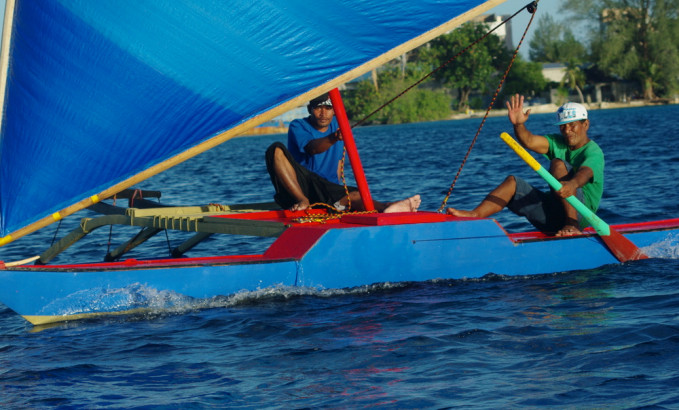
Saturday, February 21 was a beautiful day for sailing and it was wonderful to see so many colorful canoes competing in the Majuro Day Canoe Races. And the winners are:
CLASS A – KORKOR
1st Place, Wola I Wola O, owned by Sandy Alfred, skippered by Aembi Snight
2nd Place, Di In Ek, owned by Acme River, skippered by Paul River
3rd Place, Rakjen Maan, owned by Randy Abot, skippered by Sammy Abija
CLASS B – TIPNOL
1st Place, Kibed, owned by Sandy Alfred, skippered by Jebi Langineo
2nd Place, Bud Lite, owned by Albert Albertar, skippered by Reed Wonne
3rd Place, Bud, owned by Albert Albertar, skippered by Risen Aluka
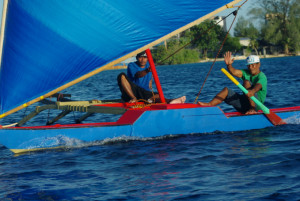
Di In Ek, skippered by Paul River, heads for home after placing 2nd in the Majuro Day 2015 Canoe Race.
All photos: Bruce Masterson
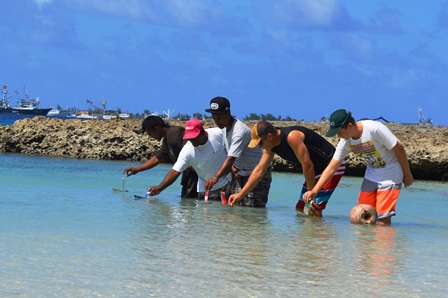
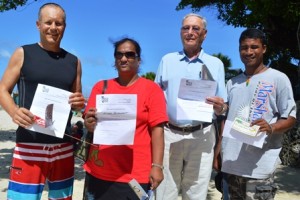
Grant Bilyard (second), Moten Naisher (participant’s prize), Dr. Bob Blue (first), and Linton Baso (third). Photo: Karen Earnshaw
WAM instructor Linton Baso came third in the grand final of last weekend’s annual Mieco Beach Yacht Club Recycle Can Race, while colleague Binton Daniel made the finals. WAM friend Davidson David ‘crewed’ for Canvasback’s Dr. Bob Blue, whose little aluminum boat took out first place overall. The WAM team made the boats, so it was fitting that they did well in the competition. A record 38 boats took part in the race. Pictured above are Davidson David, Binton Daniel, Linton Baso, Grant Bilyard and his son Tayne in the grand final of the Mieco Beach Yacht Club Recycle Can Race. Photo: Karen Earnshaw
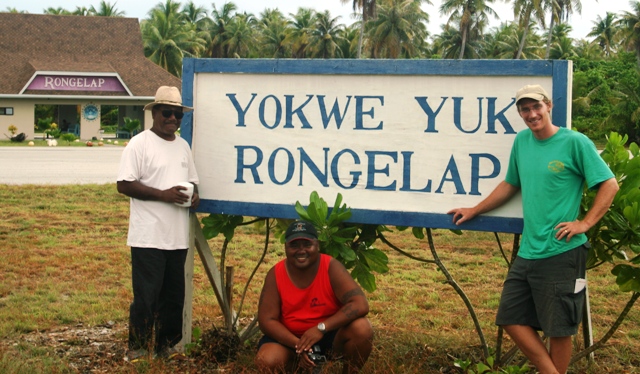
The plan to begin coaching a new generation of traditional navigators this summer has taken another leap towards reality thanks to a grant for Waan Aelõñ in Majel (WAM) from an organization linked to National Geographic.
The Genographic Legacy Fund is providing $25,000 for the project, which is officially called the Preservation and Training of Marshallese Voyaging and Navigation.
Joe Genz, the Assistant Professor of Anthropology at the University of Hawaii at Hilo, who has worked on the navigation program for many years with WAM director Alson Kelen, is thrilled with the news of the grant. “The National Geographic grant will substantially move WAM’s navigation program forward by supporting a long-distance canoe voyage on which a younger generation can begin to learn the traditional Marshallese methods of wave navigation.
“Passing on this knowledge now is critical to the safeguarding of Marshallese voyaging for future generations.”
The grant follows an equally generous donation of $31,000 to WAM from the US Ambassador’s Fund for Cultural Preservation, which was provided in September last year.
Kelen said National Geographic has long had a relationship with the Polynesian Voyaging Society. “He realized that what we’re doing at WAM is the same goal as the Society’s, so he approached National Geographic to see if they would want to support us. Both programs are all about teaching youth about traditional skills by reviving those skills and passing them on down.
“As well, we know that there aren’t too many skilled navigators left today, so time is of the essence.”
There is already a lot of work being done on the project, especially at the university in Hawaii, Kelen said. “There’s a team working on devices that will help us understand the traditional navigation in a scientific way. This is one of the requests from our master navigator Captain Korent Joel. He’s very keen to see the scientific knowledge and compare it to what he knows, so that we can all understand it better.”
Here in the Marshalls, Alson is beginning the process of following tradition in selecting the first group of novices for the summer canoe program. “Joe and I have been working on this for years and we are now about to see our efforts come to fruition,” Kelen said. “This is a time we’ve long been waiting for and now it’s nearly here we’re very excited!”
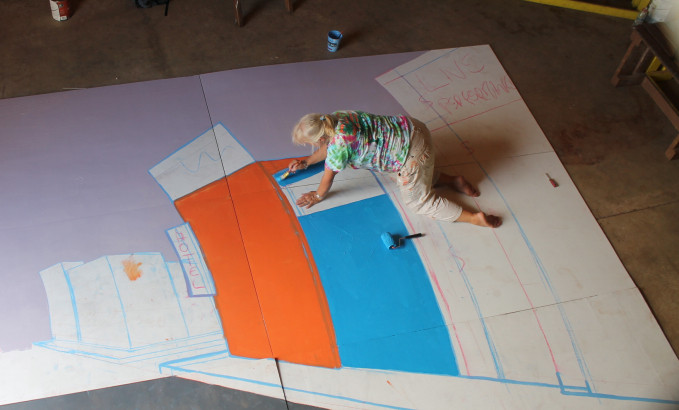
Tuesday, March 3, to Saturday, March 7: WAM gets involved in lots of great projects going on around town, including the musical Guys and Dolls, which premiers March 3 at the International Conference Center, Delap. The play is produced under the auspices of the Youth Bridge Global and is directed by Professor Andrew Garrod of Dartmouth College with youth from all around Majuro starring. What parts did WAM play? First, WAM Director Alson Kelen is the traditional translator for the Professor’s annual plays and this year is no exception. The play will be performed in Marshallese with the musical numbers sung in English. Second, the play’s artists needed a big open space to create the sets, so Apo Leo, Alexis Bilyard, Rebecca Lathrop and David Fisher, along with many student volunteers, were welcomed to WAM and you can see their efforts on stage from 8pm each evening this week.
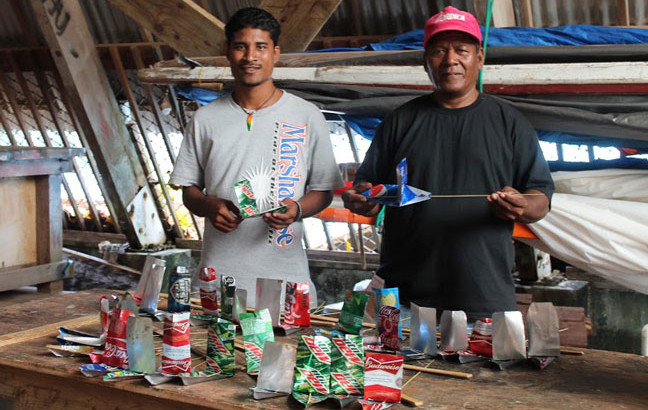
The WAM construction team has been busy building boats for the Mieco Beach Yacht Club’s annual Recycle Can Race on the afternoon of Sunday, February 8, at the Marshall Islands Resort’s beach. This is often voted as the yacht club’s best event of the year. You come along and buy a boat for $5 and see if you’re America’s Cup material by competing in the elimination heats! Pictured are Linton Baso and Binton Daniel with the newly-made boats, which earn WAM a nice bit of pocket money. Photo: Laura Masterson.
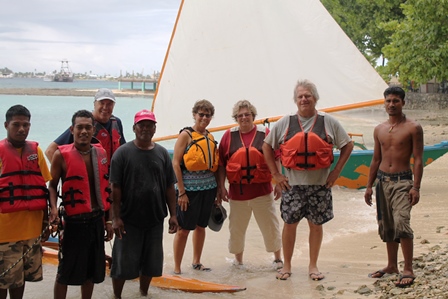
On Saturday, January 17, friends of WAM from the US Embassy and their visiting guests from Minnesota, US, went on a canoe ride between torrential rain-squalls and had the time of their lives! They sent kudos to these spirited sailors and their skillful crew with the words: “Should have done this months ago! Great sail, great sailors.”
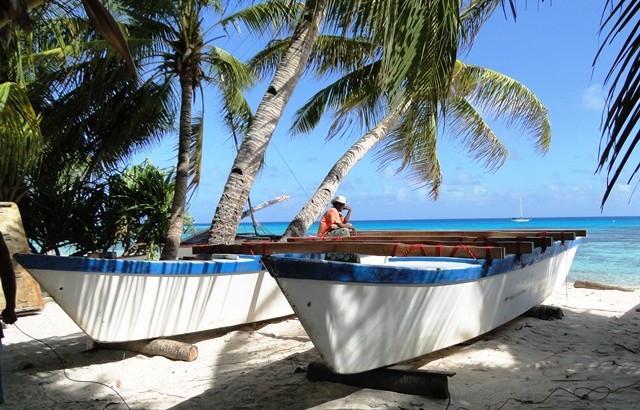
Ten years ago, the Local Government of Ailuk Atoll commissioned WAM to design and build a unique style of canoe. The council had decided the atoll was in need of a workhorse that would complement the many traditional canoes that were in everyday use on the atoll.
Ailuk’s islands run along the western side of the atoll in a north-south direction, while the eastern shore is mostly just coral walls. The prevailing north-east winds make this layout of the islands perfect for reaching (sailing with the wind on the beam) between the main island of Ailuk Ailuk, the northern community of Enejelar, and the uninhabited islands in between. While these middle isles no longer have villages, they are often visited for the harvesting of coconuts for copra, which makes for a heavy load.
It was decided that a catamaran-style, double-hulled canoe could support a strong, wide platform, as well as provide double the amount of storage in the hulls. Ailuk officials approached the Embassy of the Republic of China (Taiwan) and was given a grant to pay for the building of the catamaran.
And so it was that the instructors and trainees in the 2004 program built the canoe, giving it a bright blue and white paint job, with contrasting red lashings.
The canoe was delivered to Ailuk, where it was immediately put to service. But, as the years slipped by, even the sturdiest of objects will succumb to the elements of a low-lying outer island. And so, in 2013, a grant was successfully sought from the Ministry of Internal Affairs and a team was chosen to do a refit of the catamaran. The RMI National Training Council also assisted with funding for the project.
Team leader of the refit was Rice Snight, a champion canoe sailor, who over the years has often come to Majuro to compete in the annual National Cup. The refit took a number of months, but by early 2014 was back in action on Ailuk’s lagoon.
 In November, 2006, WAM co-founder Dennis Alessio wrote an article for the Micronesian Journal of the Humanities and Social Sciences titled Waan Aelon in Majel: Cultural Development in the Marshall Islands. The Journal’s web site can be found at http://marshall.csu.edu.au/MJHSS/
In November, 2006, WAM co-founder Dennis Alessio wrote an article for the Micronesian Journal of the Humanities and Social Sciences titled Waan Aelon in Majel: Cultural Development in the Marshall Islands. The Journal’s web site can be found at http://marshall.csu.edu.au/MJHSS/
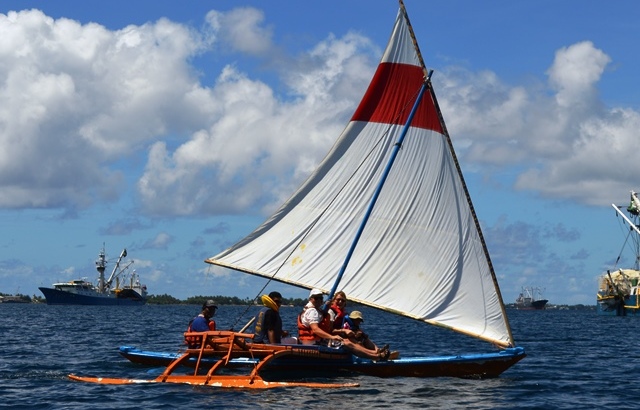
‘Our sail guides were very skilled and the ride was very smooth.’

Olli-Pekka and Auli Ollila take their grandson Gideon for a smooth ride on a WAM canoe. Photo: Karen Earnshaw
Four years ago, Mikko and JoAnn Ollila, who live in Seattle, came to Majuro to adopt their son Gideon. In the four weeks that they spent in Majuro, Mikko said that “aside from Gideon, sailing the lagoon with WAM was my most enduring and fun memory of the Marshall Islands.”
In late 2014, the couple returned with their two children and Mikko’s parents from Kangasala, Finland. Mikko said: “When we had a chance to return today, I told my parents that sailing the canoe with WAM was a must-do. I was so excited that they could do that with my son Gideon. It was really special for us.”
Here’s what his parents had to say:
Olli-Pekka: “Our son Mikko told us that the canoe sail was wonderful. And it was. It was a great day out on the water – and a great way to see the island and enjoy the weather and waters of the Marshall Islands”
Auli: “Our sail guides were very skilled and the ride was very smooth. It was so smooth that our grandson Gideon even fell asleep for a few minutes! We loved it.”
VIDEO: The late Lijon Eknilang, a master navigator from Rongelap Atoll, reads a traditional Marshallese navigation chant. A chant is called a ‘roro’ in Marshallese. Chants are integral elements in many Marshallese folktales.
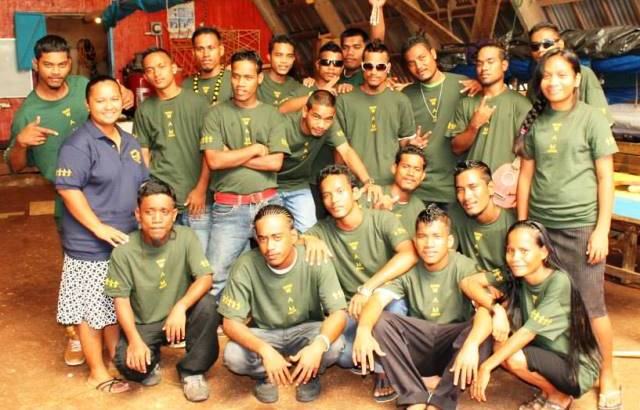
Emotions ran high at the graduation of the WAM Class of 2014, with proud smiles being the order of the day. The keynote address was presented by Chief Secretary Casten Nemra and WAM Director Alson Kelen also spoke to the trainees and their friends and families, but one of the biggest highlights of the October 2 ceremony was the speech made by star trainee Etmina Mojilong on behalf of her peers:
My joie is Ejowa and I live in Rita with my mother and father, brothers and sister. I am 22 years old and I graduated from Marshall Islands High School in 2011. Right after high school I enrolled in CMI (College of the Marshall Islands) and took developmental English and Math. After three semesters, I decided I needed to find a job that would let me contribute to my family’s finances.
I worked at a small store in Rita for a while, but it was not what I really wanted to do. I couldn’t go back to school because I owed the school and had no way to pay it back. I was feeling kind of lost and not sure what to do for myself, so this year, when one of my friends told me about the canoes program, I applied and was accepted.
I wasn’t sure what I wanted from the program, except I heard that I would learn about my culture and that It might help me get a job. I did learn about my culture. I learned about the names of the parts of the canoe and how they are related to our culture and what they mean in our culture. I learned how to sail a canoe, which was very exciting for me.
But I learned so much more. I learned how to use hand tools and power tools and how to measure using a measuring tape. I learned how to work with patterns and designs and how to put things together carefully. I learned how to follow instructions.
But I also learned about myself. I learned about self-discipline, about achieving goals, about being part of a group. I learned that I can do anything a man can do if I just learn how.
I would like to thank my counselor Tolina Tomeing for her guidance and help. I would like to thank the carpentry instructors Linton, Binten, Maston, Isocker for teaching me carpentry. I would like to thank Linton for helping me with math. I would especially like to thank Binten and Linton who taught me how to sail the canoe, even though I am a woman. I would like to thank Ken for teaching me how to build a rowboat and how to manage time. I would like to thank Bonny for helping me improve my English skills in reading, writing and speaking Englih.
And, finally, I would like to thank Mr. Kelen for letting me in this program and for giving us all this opportunity to improve ourselves as Marshallese citizens.










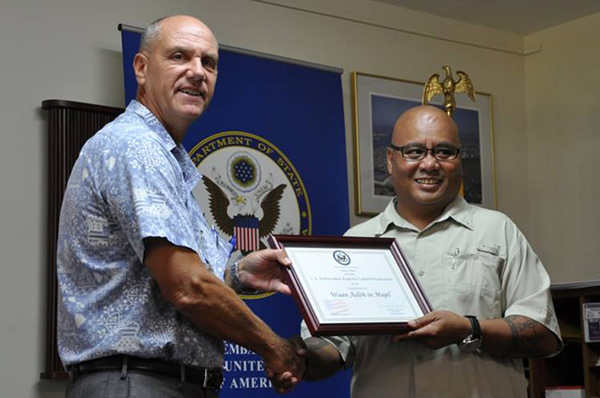
“Kapeel in meto”, translates to mean, “The skill of the ocean…”, this is what a $31,000 grant to Waan Aelõñ in Majel (WAM) will help preserve. The money comes from the U.S. Ambassador’s Fund for Cultural Preservation and was one of only 47 such grants around the world this year. Embassy Majuro congratulates the students and staff at WAM as they navigate into a future that will be more secure when these vital skills are secure.
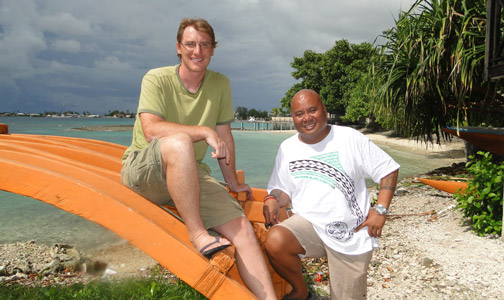
The next key stage of the traditional Marshallese navigation revival project that began in the early part of the last decade is now being planned by Waan Aelon in Majel Director Alson Kelen, expert navigator Captain Korent Joel, and anthropologist Joe Genz. Having researched, re-enacted, and documented much of the uniquely Marshallese skill of navigating using the wind and wave patterns, the trio is now working out how best this important cultural knowledge can be passed on to a new generation of sailors. Karen Earnshaw reports.
In the early days of Waan Aelon in Majel, more often known as WAM or the Canoe House, when Dennis Alessio and his recruit Alson Kelen were eagerly working on tapping into the knowledge of the Marshalls’ master canoe builders, American Joe Genz arrived on the scene.
“I had been in the Peace Corps in Samoa in the late 1990s, where I became interested in traditional navigation.” This transformed into a fascination that led to meet the University of Hawaii’s Ben Finney, who was a co-founder and first president of the Polynesian Voyaging Society. “Ben took me on as his last student in 2001,” explained Joe as he sat in WAM’s upstairs office.
“Ben had already been in conversations with Dennis and Alson about reviving the Marshallese skill of navigating, and he asked me if I would be interested in assisting in the project.” First he spent two months on Ailuk to begin learning the language and about the culture. “It was full immersion and very effective, especially as no-one really spoke English.”
Joe went back to university, finished his master’s degree, and began preparing for his PhD in anthropology, returning to RMI in 2005 to work for a year with the twin goals of researching Marshallese navigation techniques and assisting with the revival aspect of the WAM project.
“Our starting point was going with Captain Korent to his home island of Rongelap. He wanted to start talking about how he learned navigation as a child. On Rongelap he took us to a reef that simulates the water patterns. This was where he began his lessons in navigation from his grandfather.”
At this time, the only master navigator alive was Thomas Bokin of Ujae. “But in addition to Thomas and Captain Korent, there were six other experts in navigation, primarily from Rongelap, including Isao Eknilang,” Joe said. “And they weren’t all men. One was Lijon Eknilang, Isao’s younger sister.” Of these eight, three have now passed on, including Lijon.
“Of course the secrets of the skills of navigation are still very much under traditional chiefly control and there are strong regulations controlling the dissemination of this knowledge,” Joe explained, adding, however, that there is a general perception that there is a need to keep the skills alive and that this can really only happen with an ongoing training program.
“So, for example, it was okay for Captain Korent to take Alson on as a novice, because Alson is from the same family.”
Alson and Joe worked with the elders for a year. During this time, Joe organized for the deployment of a ‘wave buoy’ in many locations around Majuro and Arno. “We used this scientific instrument to try to understand and document how the waves can be used for navigation.” Joe’s year in RMI culminated in using a yacht loaned by two guys from Kwajalein to test Captain Korent’s skills.
“On that first voyage in 2006, we sailed 120 miles from Kwajalein to Ujae and back, and the captain made it with no navigational help from any of the devices on board the yacht Mali. “A bonus of this voyage was that while we were in Ujae Captian Korent spent a lot of time talking stories with Thomas the navigator. Another important note is that for Captain Korent it was his ‘ruprup jokur,’ which means ‘breaking out of the turtle shell’ or, more plainly, his coming of age as an expert navigator. He would have earned this earlier on, in Rongelap, but the movement of the people back when he was young had disrupted this step.”
Joe left RMI again to continue his PhD — which he achieved in 2008 — returning to do more research in the summers of 2007 and 2009. “Our intention was to do another voyage to test the navigation skills, this time using a large voyaging canoe, but each time there was no wind. The whole place was completely becalmed.”
Finally, in 2010, Alson successfully sailed WAM’s big canoe to Aur. There were six crew on board. “Captain Korent was on a chase boat, ready to give navigational guidance via radio to Alson if and when he needed assistance.”
In 2012, Joe was hired as an Assistant Professor in the Department of Anthropology at the University of Hawaii at Hilo and this allowed him to apply for funding to continue the navigation project with Alson. This includes a grant from the United States Ambassador’s fund. “I am here now to work out how we can best continue the program,” Joe said. “We still don’t have all the answers on how to read the waves, but we feel the most important thing is the passing on of the skills.
In Hawaii, a similar process of connecting to the past led to the building of the famous double-hulled canoe Hōkūleʻa, which has just now embarked on a three-year voyage around the world to raise awareness of environmental stewardship.
“Alson’s idea as of now is to organize a voyage next summer that will include novice navigators, who will be chosen with great care and using the correct channels, with the ultimate hope of reviving the voyaging canoes as a means of sustainable water transport.”
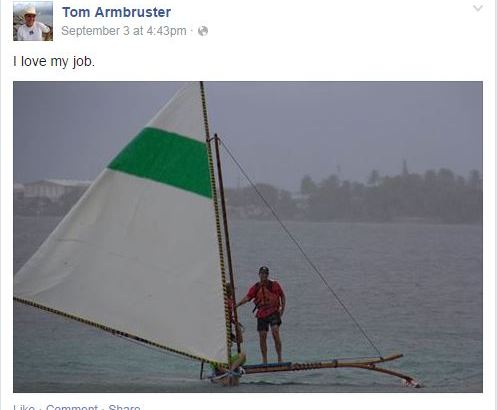
The United States Ambassador to the Marshall Islands Tom Armbruster posted an item on facebook on September 3, 2014. He decided to let the photo of him on a traditional Marshallese canoe say it all by simply adding the words: “I love my job.”